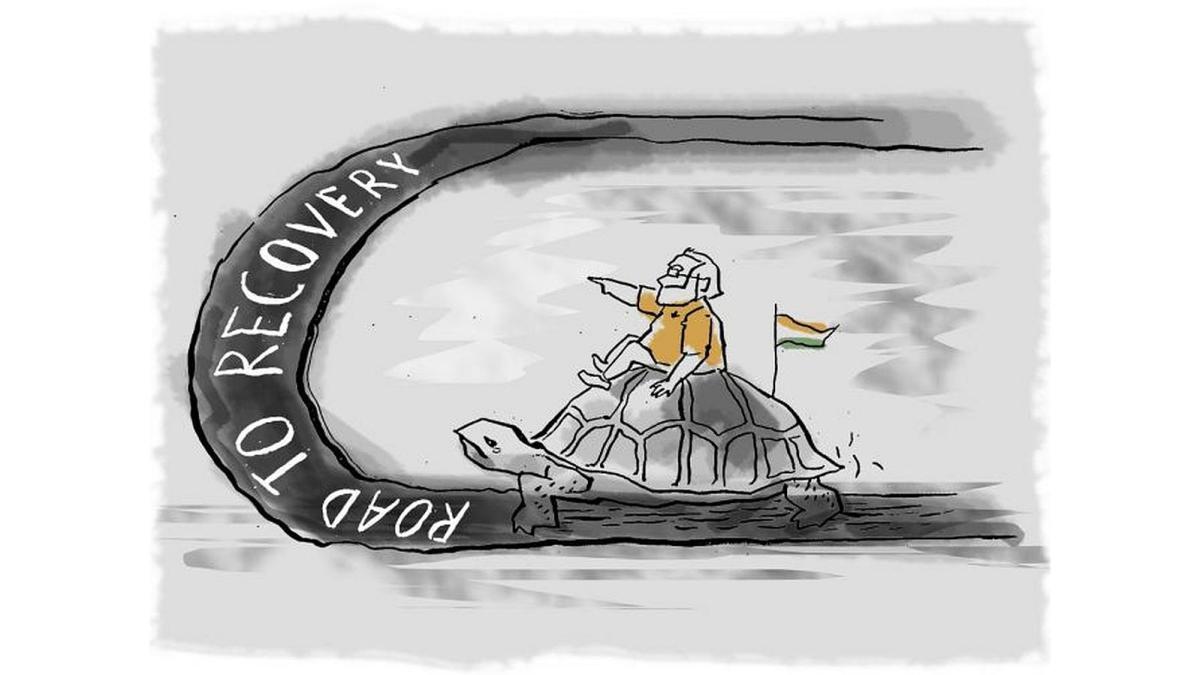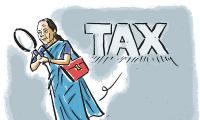India's Income Inequality Declines: SBI Debunks K-Shaped Recovery
SBI research shows income inequality in India has declined, with more taxpayers moving to higher income brackets. The report refutes the K-shaped economic recovery theory.

Illustration: Dominic Xavier/Rediff.com
New Delhi, Jan 8 (PTI) Income inequality in India has declined, with more than a third of taxpayers moving to higher income tax buckets, while top taxpayers' contributions declining, the Economic Research Department of SBI said in a report, rebutting talks of K-shaped post-pandemic recovery.
In a K-shaped recovery, some parts of the economy may experience strong growth while others continue to decline. Some economists, including former RBI governor Raghuram Rajan, have often referred to India's post-pandemic economic growth as K-shaped.
SBI research paper said the K-shaped recovery seems "at best flawed, prejudiced, ill-concocted and fanning interests of select quarters to whom India's remarkable ascendance, signalling more the renaissance of the new global south, is quite unpalatable".
"Income inequality captured through the Gini coefficient (one of the most widely used measures of income inequality) of taxable income has declined significantly from 0.472 to 0.402 during FY14-FY22," it said.
While 36.3 per cent of taxpayers have moved from lower income to higher income tax bucket, resulting in 21.3 per cent additional income, the top 2.5 per cent of taxpayer's contribution in income has declined from 2.81 per cent to 2.28 per cent during FY14-FY21 (April 2013-March 2014 fiscal year to April 2020-March 2021 fiscal).
It went on to state that 19.5 per cent of small firms have transitioned into larger firms through MSME value chain integration and consumption of the bottom 90 per cent of the population has increased by Rs 8.2 lakh crore post-pandemic.
With the rise of income in the rural economy, people are substituting two-wheelers for four-wheelers.
As many as 15 per cent of taxpayers in India are women taxpayers, it said, adding two crore family members are consuming food through Zomato from semi-urban areas.
The report for the first time in the Indian context used publicly available income tax data to measure the estimates of inequality.
According to recent data, the income-tax returns (ITRs) filed by individual taxpayers earning between Rs 5 lakh and Rs 10 lakh, climbed by 295 per cent in the assessment years (AY) A 201314 and AY 202122, showing a positive trend of migration to a higher range of gross total income.
The number of ITRs filed by people earning between Rs 10 lakh and Rs 25 lakh has increased by 291 per cent while the total number of persons filing income tax increased to 7.4 crore in AY23 from 7 crore in AY22. For AY24, 8.2 crore ITRs have been filed by December 31, 2023.
The Gini Coefficient is one of the most widely used measures of income inequality. The Gini coefficient estimated using ITR data of taxable income of individuals shows that individual income inequality has decreased from AY15 (FY14) to AY23 (FY22) from 0.472 to 0.402. Further, based on past trends, SBI projects that the Gini coefficient will further decrease to 0.402 in AY23.
According to income tax data, 36.3 per cent of individual ITR filers belonging to an income group of less than Rs 3.5 lakhs in AY15 (FY14) have left the lowest income group and shifted upwards. 15.3 per cent have shifted each in the income group of Rs 3.5 lakhs to 5 lakhs, and Rs 5 lakhs to 10 lakhs, 4.2 per cent people shifted in the income group of Rs 10 lakhs to Rs 20 lakhs and the rest further upwards.
It said 21.1 per cent of the gross income of the lowest income group of lower than Rs 4 lakhs has shifted upwards, with 6.6 per cent gross income shifted towards Rs 4 lakhs to Rs 5 lakhs group, 7.1 per cent towards Rs 5 lakhs to Rs 10 lakhs group, 2.9 per cent towards Rs 20 lakhs to Rs 50 lakhs group, and 0.8 per cent in Rs 50 lakhs to Rs 1 crore group.
The income disparity of people earning less than Rs 3.5 lakh has declined from 31.8 per cent to 15.8 per cent during FY14-21, signifying that the share of this income group in the total income in comparison to their population has increased by 16 per cent, the report said.
On the share of top taxpayers in income, the report said that in FY14, the combined income of 23 individuals with income of more than Rs 100 crore was 1.64 per cent of the total income of FY14. Even though the number of such individuals has increased to 136 in FY21, the share of their combined income in FY21 has fallen to 0.77 per cent.
According to the report, post-pandemic, households are reconfiguring their savings towards physical assets, including real estate.
In a K-shaped recovery, some parts of the economy may experience strong growth while others continue to decline. Some economists, including former RBI governor Raghuram Rajan, have often referred to India's post-pandemic economic growth as K-shaped.
SBI research paper said the K-shaped recovery seems "at best flawed, prejudiced, ill-concocted and fanning interests of select quarters to whom India's remarkable ascendance, signalling more the renaissance of the new global south, is quite unpalatable".
"Income inequality captured through the Gini coefficient (one of the most widely used measures of income inequality) of taxable income has declined significantly from 0.472 to 0.402 during FY14-FY22," it said.
While 36.3 per cent of taxpayers have moved from lower income to higher income tax bucket, resulting in 21.3 per cent additional income, the top 2.5 per cent of taxpayer's contribution in income has declined from 2.81 per cent to 2.28 per cent during FY14-FY21 (April 2013-March 2014 fiscal year to April 2020-March 2021 fiscal).
It went on to state that 19.5 per cent of small firms have transitioned into larger firms through MSME value chain integration and consumption of the bottom 90 per cent of the population has increased by Rs 8.2 lakh crore post-pandemic.
With the rise of income in the rural economy, people are substituting two-wheelers for four-wheelers.
As many as 15 per cent of taxpayers in India are women taxpayers, it said, adding two crore family members are consuming food through Zomato from semi-urban areas.
The report for the first time in the Indian context used publicly available income tax data to measure the estimates of inequality.
According to recent data, the income-tax returns (ITRs) filed by individual taxpayers earning between Rs 5 lakh and Rs 10 lakh, climbed by 295 per cent in the assessment years (AY) A 201314 and AY 202122, showing a positive trend of migration to a higher range of gross total income.
The number of ITRs filed by people earning between Rs 10 lakh and Rs 25 lakh has increased by 291 per cent while the total number of persons filing income tax increased to 7.4 crore in AY23 from 7 crore in AY22. For AY24, 8.2 crore ITRs have been filed by December 31, 2023.
The Gini Coefficient is one of the most widely used measures of income inequality. The Gini coefficient estimated using ITR data of taxable income of individuals shows that individual income inequality has decreased from AY15 (FY14) to AY23 (FY22) from 0.472 to 0.402. Further, based on past trends, SBI projects that the Gini coefficient will further decrease to 0.402 in AY23.
According to income tax data, 36.3 per cent of individual ITR filers belonging to an income group of less than Rs 3.5 lakhs in AY15 (FY14) have left the lowest income group and shifted upwards. 15.3 per cent have shifted each in the income group of Rs 3.5 lakhs to 5 lakhs, and Rs 5 lakhs to 10 lakhs, 4.2 per cent people shifted in the income group of Rs 10 lakhs to Rs 20 lakhs and the rest further upwards.
It said 21.1 per cent of the gross income of the lowest income group of lower than Rs 4 lakhs has shifted upwards, with 6.6 per cent gross income shifted towards Rs 4 lakhs to Rs 5 lakhs group, 7.1 per cent towards Rs 5 lakhs to Rs 10 lakhs group, 2.9 per cent towards Rs 20 lakhs to Rs 50 lakhs group, and 0.8 per cent in Rs 50 lakhs to Rs 1 crore group.
The income disparity of people earning less than Rs 3.5 lakh has declined from 31.8 per cent to 15.8 per cent during FY14-21, signifying that the share of this income group in the total income in comparison to their population has increased by 16 per cent, the report said.
On the share of top taxpayers in income, the report said that in FY14, the combined income of 23 individuals with income of more than Rs 100 crore was 1.64 per cent of the total income of FY14. Even though the number of such individuals has increased to 136 in FY21, the share of their combined income in FY21 has fallen to 0.77 per cent.
According to the report, post-pandemic, households are reconfiguring their savings towards physical assets, including real estate.
You May Like To Read
TODAY'S MOST TRADED COMPANIES
- Company Name
- Price
- Volume
- Vodafone-Idea
- 11.28 ( -0.70)
- 49477732
- Shish-Industries
- 9.13 ( -7.22)
- 45801742
- Sylph-Technologies
- 1.04 (+ 7.22)
- 30393304
- Welcure-Drugs-and
- 0.47 ( -2.08)
- 28770740
- Sunshine-Capital
- 0.27 (+ 3.85)
- 14215639





